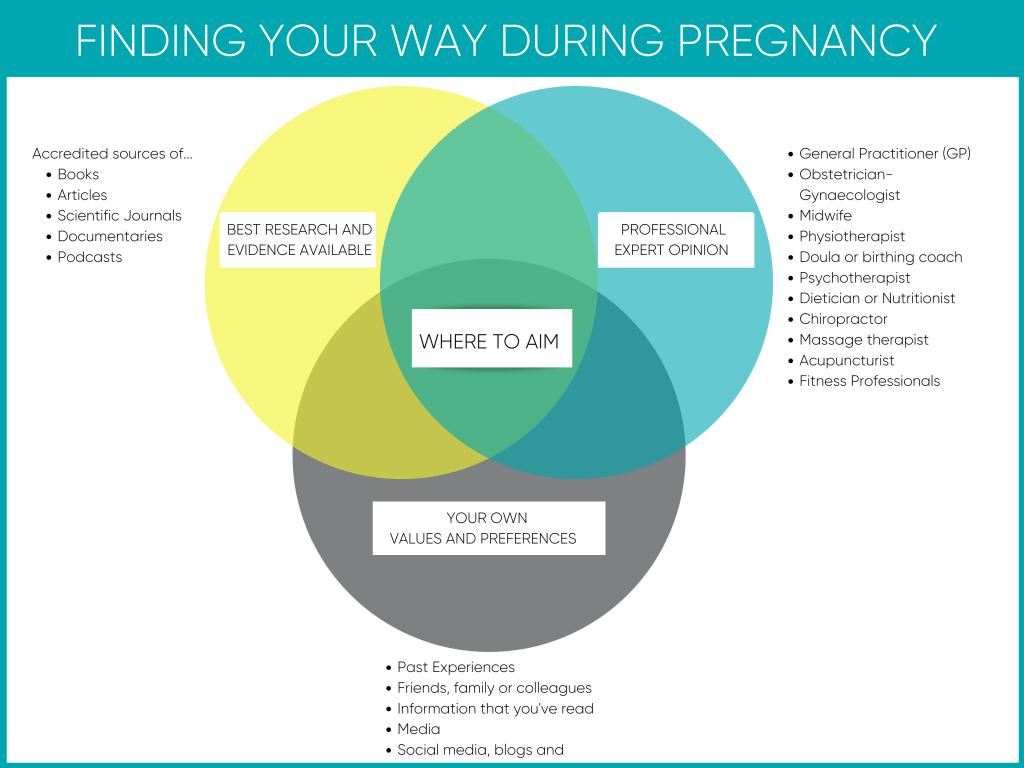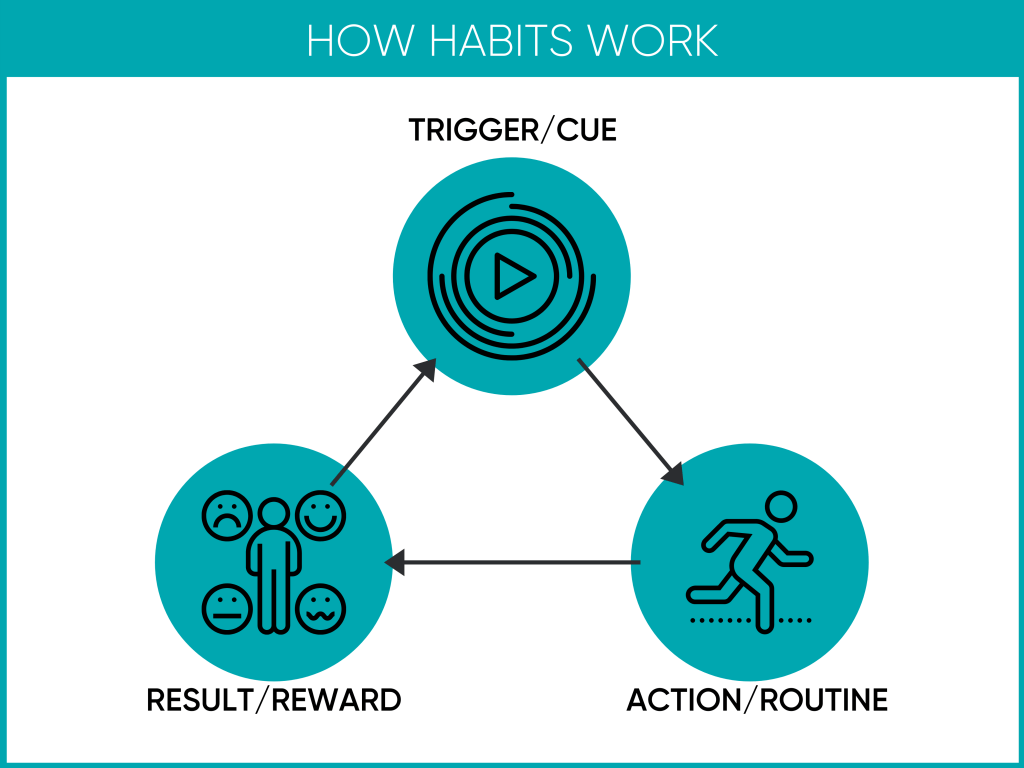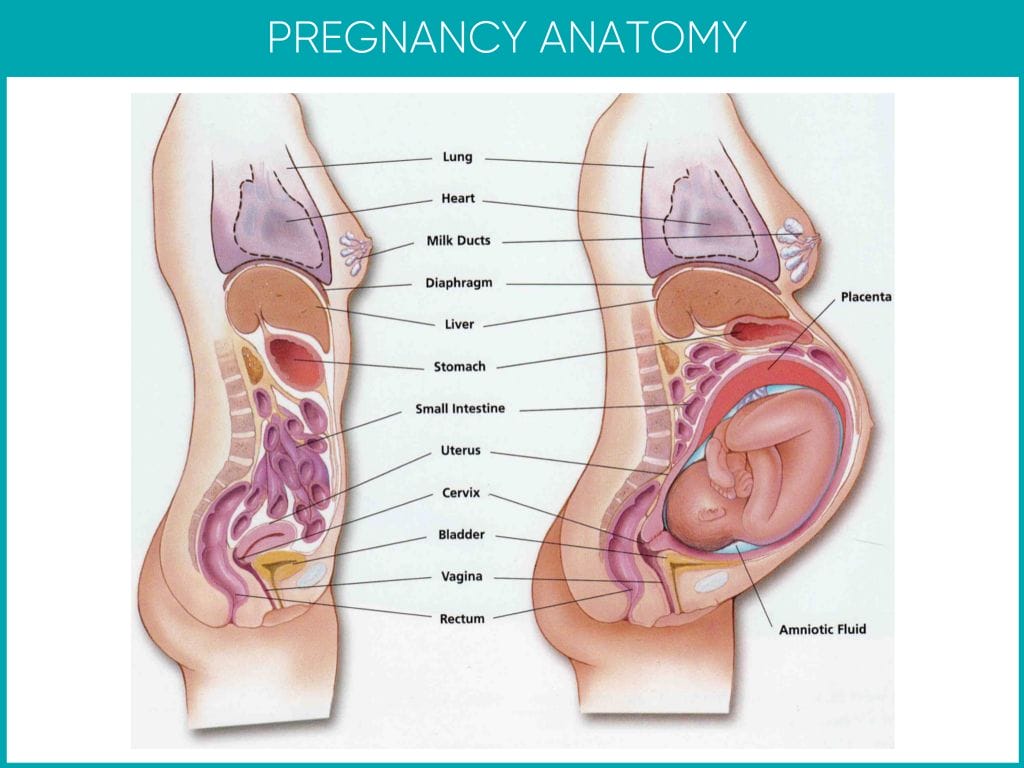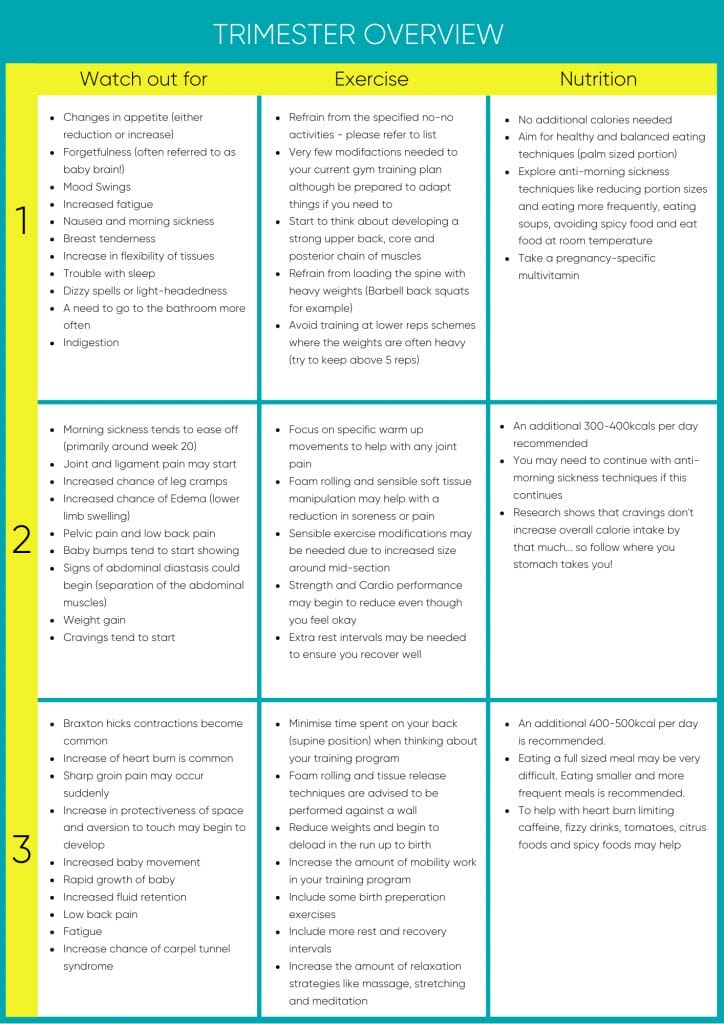This diagram gives you a visual comparison between the cross-section of the female anatomy before conception and just before giving birth. Whilst there are many stages during pregnancy, there are some key areas of your anatomy that are going to change, which is important to know about in relation to your exercise plan.
The Stomach and the Lungs
As the pregnancy progresses, the baby, the placenta and fluids increasingly take up space inside the abdominal cavity. Because of this, the stomach will have less capacity for food and the diaphragm can ascend by as much as 5cm (as the ribcage rises and expands). As a consequence, it’s likely that the portion sizes you eat may have to reduce in size, and eating smaller and more often may be a preferred strategy. Breathlessness is also more common, and this of course can affect your ability to exercise, so you may find you’re not able to work out as hard as you’d like and feel that you get out of breath quite quickly. The diaphragm is integral to core function, so retaining its strength and endurance during and after pregnancy is very important.
Hormonal Changes
Conception triggers a dramatic change in a woman’s hormone levels. These hormones are what drive the biological change in your body (and also how you feel too). Below is a quick overview of the main hormonal changes that we think are worth knowing about in relation to exercise, as they can affect your performance and energy levels;
- Oestrogen and Progesterone steadily increases and can elevate by up to 30 times the normal level by the end of pregnancy. This hormone will trigger the change in tissues that lead to greater flexibility or laxity around joints and the pelvic floor.
- Relaxin increases quickest in the first trimester and (as the name would suggest) it’s responsible for creating greater flexibility or laxity of tissues too.
- Thyroid and Parathyroid hormones increase quite substantially. This will affect your metabolism, but it will also regulate blood calcium levels. It’s important to ensure your calcium intake is adequate by eating a well-rounded and healthy diet consisting of calcium-rich foods like dairy and dark leafy greens.
Posture and Associated Pain
Changes in posture during pregnancy are not as easy to predict as you may think. Some research shows that the curve of the lower (lumbar) spine increases over the course of their pregnancy whilst other research shows the direct opposite (2,3&4). As well as this, we need to consider different types of posture; from sitting to standing, walking and exercising. Finally, understanding that an increase in pregnancy hormones (in particular Relaxin) can reduce the tension of our muscles, tendons, ligaments and connective tissue (5), may affect posture. With all this in mind, I’m sure you can appreciate it’s quite a broad and complex topic!
What we can say with some certainty, is that your posture will change and your tissues will become more flexible; but how that change will look and whether or not you’ll have pain associated with this change is quite hard to predict. It may seem frustrating that no definitive answers can be given, but you should be expectant of change and accepting of the fact that whatever happens to you along your journey is likely to be within the wide range of normal. Keeping active and moving often will give you the best chance at managing any posture-related pain, but if things get serious or go downhill rapidly, then it’s recommended that you reach out to a professional like your GP or a physiotherapist.
“We must remind ourselves that there is a wide range for
what is ‘normal’ during pregnancy”
(Girls Gone Strong – Pre & Postnatal coaching certification manual)
Metabolic Changes and Weight Gain
A woman’s basal metabolic rate (BMR – the amount of energy the body needs to function at rest) increases throughout pregnancy. How much the BMR increases vary considerably for each person. For example, in a study of over 250 women (6), the average increase in BMR was 4% in the first trimester, 10% in the second trimester and 24% in the third trimester. However, this study also showed large individual variation, with one participant showing an increase of 63.7% at week 32 of pregnancy!
Alongside the increase in BMR, there is a healthy amount of weight gain to be expected. Most doctors will record their patients’ weight throughout pregnancy to ensure that an ‘ideal’ amount of weight is being gained and the baby is growing at a healthy rate, and it’s advised that you follow your doctor’s advice here. It’s probably a good time to stop tracking bodyweight with a personal trainer but if you continue to monitor this yourself, then it’s good to know what weight gain you should expect …
- The total recommended amount of weight gain is 11kg to 16kg.
- If you started your pregnancy at the lower end of the average body weight for your age and height, then it’s recommended that 12kg to 18kg is gained.
- If you start your pregnancy at the upper end of average, then 7kg to 12kg is advised.
A lot of this weight gain is not just the weight of the baby growing, it’s also due to an increase in blood, fluids and other tissues that develop during pregnancy. With that being said, these numbers are just guidelines and averages so it’s to be expected that some individuals may not follow these exact trends.
The Pelvic Floor
In conjunction with the changes in body weight and hormones, the pelvic floor also experiences significant changes, especially towards the end of the pregnancy. The downwards pressure on these deep core muscles (that sit like a hammock horizontally across the pelvis) increases as the baby grows. This, coupled with the increase of Relaxin, can lengthen and weaken the smooth muscles around the bladder. As a result, it’s common to report some incontinence, but rest assured this is totally normal. Statistics show that in early pregnancy, rates of incontinence are around 17% to 25% and can be as high as 35% to 76% in the later stages (7). Performing Kegal exercises are a great way to help maintain the strength of these muscles alongside safely performing traditional strength exercises too.
Trimester Breakdown
Over the duration of the pregnancy, there are certain elements that need particular emphasis with regards to your exercise and nutrition, which should adapt to the way your body changes and the impact this has on you. The table below provides a detailed overview of what to watch out for and how to modify your training plan according to pre/post-natal exercise guidance provided by fitness professionals.
 Tiago
Tiago








